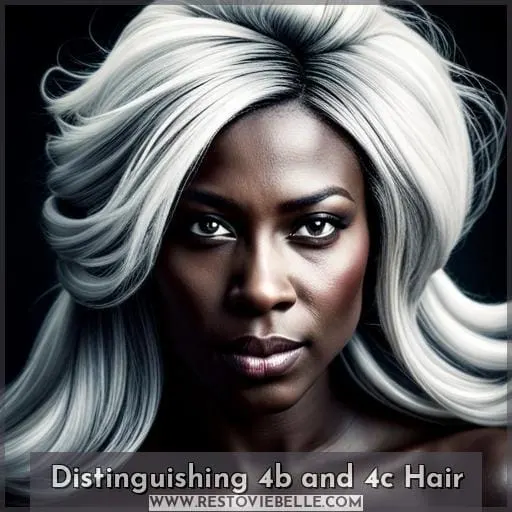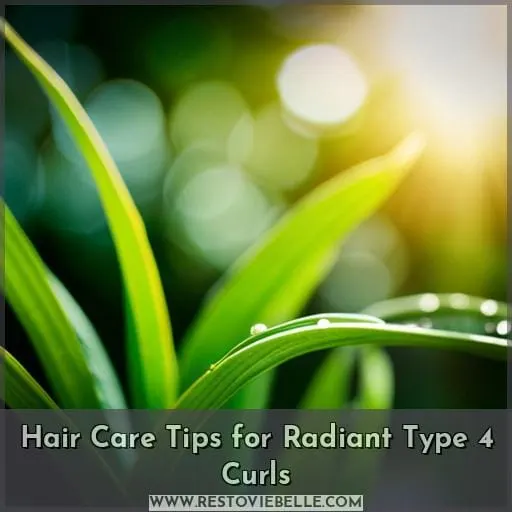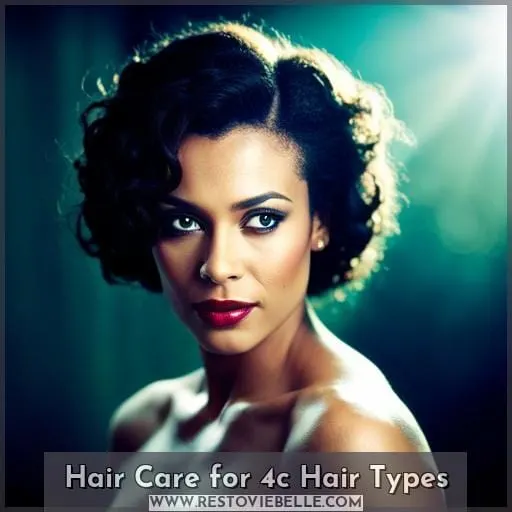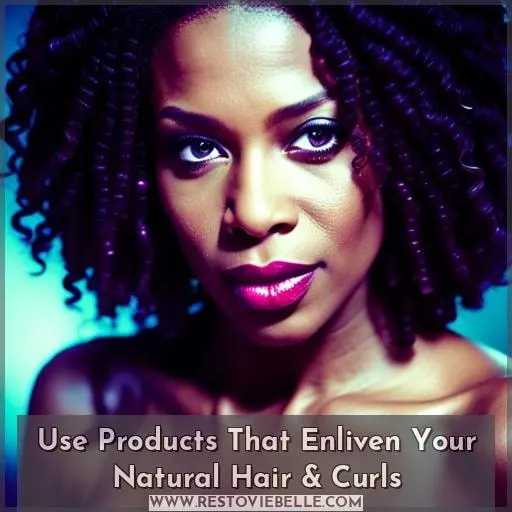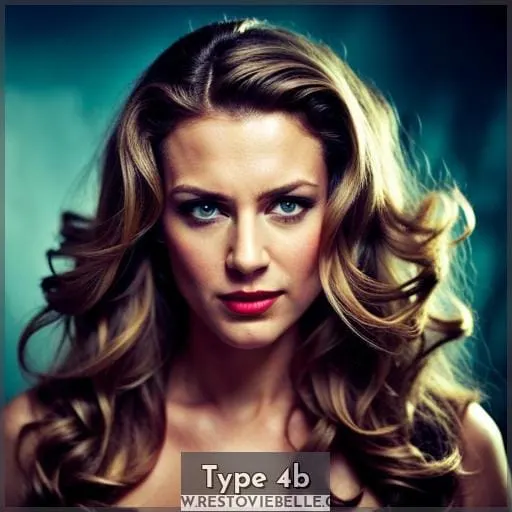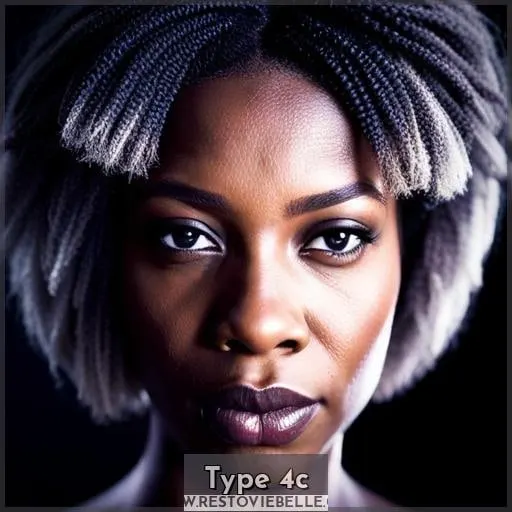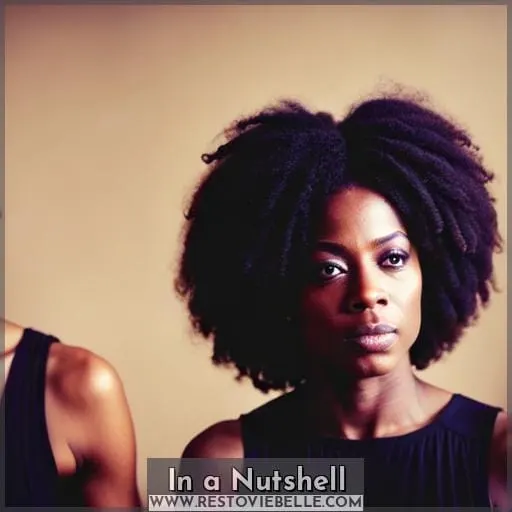This site is supported by our readers. We may earn a commission, at no cost to you, if you purchase through links.
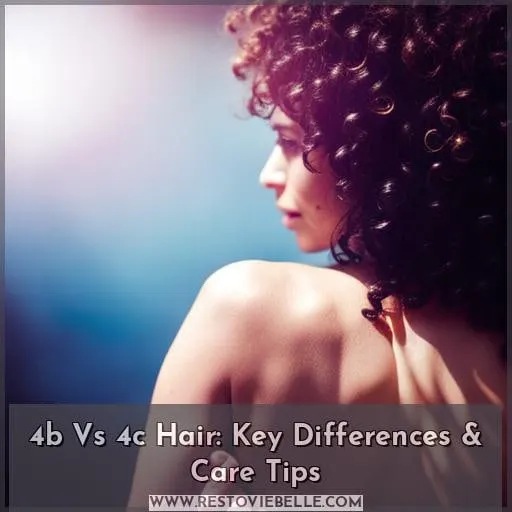 Imagine finally understanding the key differences between 4b and 4c hair, allowing you to confidently care for your unique curls. In this article, we’ll break down these two hair types and provide essential tips for keeping them healthy and radiant.
Imagine finally understanding the key differences between 4b and 4c hair, allowing you to confidently care for your unique curls. In this article, we’ll break down these two hair types and provide essential tips for keeping them healthy and radiant.
By knowing the distinctions between 4b and 4c hair, you can tailor your routine with products that enliven your natural curls.
Table Of Contents
- Key Takeaways
- Distinguishing 4b and 4c Hair
- Hair Care Tips for Radiant Type 4 Curls
- Hair Care for 4c Hair Types
- Use Products That Enliven Your Natural Hair & Curls
- Type 4a
- Type 4b
- Type 4c
- In a Nutshell
- Frequently Asked Questions (FAQs)
- What are the key differences between 4b and 4c hair patterns?
- How does the shrinkage factor differ between 4b and 4c hair?
- What are some common challenges faced by those with 4c hair?
- Are there any specific hair care techniques or products recommended for 4b and 4c hair?
- Can 4b and 4c hair types be combined or have overlapping characteristics?
- Conclusion
Key Takeaways
- 4b hair has tightly zigzagged strands resembling cotton candy, while 4c hair has even tighter coils forming voluminous afros.
- The main distinction between 4b and 4c hair lies in the size and definition of the curls.
- Understanding the specific curl pattern is crucial for proper care and product selection.
- Moisture management and protective styling are essential for maintaining the health and appearance of type 4c curls.
Distinguishing 4b and 4c Hair
When it comes to distinguishing 4b and 4c hair, there are a few key differences to look for.
- 4b hair typically has tightly zigzagged strands that resemble cotton candy,
- While 4c hair is characterized by even tighter coils that form voluminous afros.
The main distinction lies in the size and definition of the curls or coils, making visual examination against a light background helpful in determining whether you have type 4b or type 4c hair.
What is 4b Hair?
To understand the differences between 4b and 4c hair, it’s important to know what defines 4b hair.
4b hair is characterized by its tightly coiled zigzag pattern. It lacks well-defined curl shapes and can range from soft to coarse in texture.
One of the main challenges for those with 4b hair is dryness, as the sharp angles in the strands make it prone to moisture loss.
To combat this, regular moisturization using natural hair moisturizers and conditioners is essential for maintaining healthy and hydrated curls.
Additionally, protective styles like braids or twists can help prevent breakage and tangling while promoting curl definition.
What is 4c Hair?
You can distinguish 4b from 4c hair by examining the tightness and coil size of your strands.
Understanding 4C hair is essential for proper care and styling. Here are key characteristics of 4C hair:
- Coily Characteristics: It has tightly coiled strands that form small, dense curls or coils.
- Shrinkage Challenge: This type experiences significant shrinkage, making it appear shorter than its actual length.
- Moisturization Strategies: Due to its coily nature, regular moisturization is crucial to maintain pattern consistency and prevent dryness.
- Styling Versatility: Despite its unique texture, 4C hair offers versatility in terms of styling options.
- Visual Identification : Close examination against a light background aids in distinguishing between type 4B vs Type- C Hair
Hair Care Tips for Radiant Type 4 Curls
Nourishing and hydrating your Type 4 curls is essential for maintaining their radiance and health.
- Moisture Balance: Type 4 curls tend to be dry, so it’s crucial to maintain moisture balance. Deep conditioning treatments and regular moisturization with water-based products can help keep your curls hydrated.
- Protective Styling: Protecting your hair from environmental damage is key in preventing breakage. Styles like braids, twists, or updos can shield your strands while promoting growth.
- Curl Pattern Understanding: Knowing the specific curl pattern of your type 4 hair (whether it’s 4b or 4c) will allow you to choose the right products and techniques that work best for you.
- Breakage Prevention: Gentle handling of type 4 curls is vital in avoiding breakage. Finger detangling instead of using a comb or brush helps minimize damage.
- Product Recommendations: Look for quality conditioners that provide deep hydration such as SheaMoisture Jamaican Black Castor Oil Strengthen & Restore Treatment Masque or Mielle Organics Babassu Oil Mint Deep Conditioner.
By following these care tips, you’ll be able to maintain healthy and radiant type four curly hair while minimizing breakages caused by dryness or improper handling.
Hair Care for 4c Hair Types
For optimal care of your 4c hair, it’s essential to nourish and hydrate your strands.
Type 4c hair has the tightest curl pattern among all the Type 4 categories, making moisture balance crucial for maintaining healthy and vibrant curls.
To prevent breakage and promote curl definition, incorporate protective styles into your hair care routine.
These styles not only shield your fragile strands from external damage but also help in retaining moisture by reducing manipulation.
Styling techniques play a significant role in managing 4c hair.
Finger-detangling or using wide-tooth combs can minimize breakage while styling curly tresses.
Additionally, incorporating coconut oil into your routine can provide extra hydration for this particular type of hair.
To maintain proper moisture levels throughout the day with minimal shrinkage, consider utilizing the LOC (liquid-oil-cream) method when moisturizing and styling your 4c curls.
This technique involves applying water-based leave-in conditioners or creams followed by sealing in that moisture with natural oils like coconut oil.
By following these tips and understanding how to properly care for their unique curl pattern, those with type 4c hair can embrace their natural texture while keeping their locks healthy and strong.
Use Products That Enliven Your Natural Hair & Curls
Now that you have a better understanding of how to care for your 4c hair, it’s time to discuss the importance of using products that will enliven your natural hair and curls.
Curl enhancing products are essential in maintaining the natural definition and beauty of your strands. When it comes to product selection, it’s crucial to choose those specifically designed for textured hair types like yours.
Moisture retention should be a top priority when selecting products for 4c hair. Look for moisturizers and leave-in conditioners that deeply hydrate without weighing down your coils or leaving behind any greasy residue.
These products will help combat dryness, which is common among individuals with tighter curl patterns.
In addition to moisture retention, styling techniques play a significant role in achieving the desired look with 4c hair. Experimenting with different methods such as twist-outs or braid-outs can enhance curl definition while adding versatility to your hairstyle options.
When shopping for natural hair products, pay attention not only to their claims but also their ingredients list. Opting for formulations free from harsh chemicals and sulfates will help maintain the health and integrity of your strands.
By carefully selecting curl-enhancing products suited specifically towards Type 4C textures like yours while incorporating effective styling techniques into your routine; you’ll unlock endless possibilities in embracing and amplifying the beauty ofyournaturalhairandcurls
Type 4a
To enhance the natural beauty of your Type 4a hair, continue nourishing it with products that enliven your curls.
Type 4a hair is characterized by medium-sized, loosely packed curls with a springy S-shape. These curls are naturally well-defined and easier to style compared to 4b and 4c hair types.
One key factor in maintaining healthy type 4a hair is finding the right balance of moisture. Due to its curly nature, type 4a hair tends to be drier than other types, so it’s important to keep it moisturized regularly.
This can be achieved through deep conditioning treatments using quality conditioners and incorporating leave-in conditioners into your styling routine.
When styling type 4a hair, consider utilizing techniques that promote curl definition while minimizing breakage or damage caused by heat or manipulation. Protective styles like twists or braids can help protect the ends of your strands from friction and reduce tangling.
It’s also crucial for those with type-3C/Type-2A combination textures (Tightly coiled/kinky) who’ve porous strands due mostly because they may need more frequent moisturizing as their porosity levels tend towards higher absorption rates than others:
- Low-porosity individuals might find success focusing on sealing oils such as olive oil;
- High-porosity folks should opt for thicker consistency creams containing sheabutter/mango butter etc., which will prevent too much water being absorbed into each strand causing frizzing problems later down-the-line.
Type 4b
To care for your Type 4b hair, it’s important to understand its unique characteristics and implement a proper hair care routine.
Type 4b hair is characterized by tightly coiled strands that resemble zigzag patterns. Unlike Type 4a hair, which has more defined curls, Type 4b strands lack well-defined curl shapes and can range from soft to coarse in texture.
Moisture management is crucial for maintaining the health of your Type 4b curls. This hair type tends to be prone to dryness due to the sharp angles in its strands.
When selecting products for your Type 4b hair, opt for natural moisturizers and conditioners specifically formulated for curly or coily textures. These products will help nourish the strands while providing much-needed hydration.
In terms of styling techniques, finger-combing can minimize breakage and frizz with this particular curl pattern. Additionally, incorporating protective styles like braids or twists can help keep your Hair protected from damage caused by manipulation or environmental factors.
By understanding how moisture management plays a role in caring for your unique curl pattern along with utilizing appropriate styling techniques and product selection,you’ll be able maintain healthy-looking type b curls while preventing breakage
Type 4c
When it comes to Type 4c hair, you’ll notice that the tightly coiled strands form thick coils and create voluminous afros. This hair type is known for its unique characteristics, including shrinkage challenges and a common misconception about texture.
Moisturization techniques play a crucial role in caring for Type 4c hair. Due to its highly curly nature, this hair type tends to be more prone to dryness compared to other types. Using quality conditioners and moisturizers specifically formulated for curly or coily hair can help maintain moisture levels and prevent breakage.
Styling options for Type 4c hair are abundant, ranging from twist-outs and braid-outs to updos and protective styles like braids or twists that can keep the strands protected from damage caused by manipulation or environmental factors.
One challenge of having Type 4c coils is dealing with significant shrinkage when the curls contract upon drying. Embracing this natural characteristic can lead to creative styling options as well as embracing your unique coil pattern.
To protect your precious coils while promoting growth retention, consider incorporating protective styling into your routine such as wearing wigs or weaves occasionally or opting for low-manipulation hairstyles like buns or updos.
Understanding the specific needs of Type 4c curls allows you not only embrace their beauty but also empower yourself through knowledge on how best care them using proper moisturization techniques suited specifically tailored towards maintaining overall health.
In a Nutshell
In a nutshell, understanding the key differences and care tips for type 4b vs. 4c hair is crucial in achieving healthy and vibrant curls.
-
Curl Pattern:
- Type 4b hair has tight zigzag strands resembling cotton candy,
- While type 4c hair forms thick coils that create beautiful afros.
-
Moisturization Techniques:
- Both types require regular moisturization due to their curly nature.
- Use natural hair moisturizers, conditioners, oils like coconut or almond oil before washing for extra moisture.
-
Styling Options:
- Protective styles like box braids or twists can help keep your curls secure and tangle-free.
- Finger-combing can minimize breakage and frizz for type 4b hair.
-
Breakage Prevention:
- Proper care is essential to prevent breakage in both types of hair.
- Avoid excessive heat exposure and opt for minimal manipulation techniques when styling.
-
Hair Type Combinations:
- Keep in mind that not every head has just one specific hair type; combinations like 4a/4b or even more variations are possible.
By following these care tips tailored specifically to your unique curl pattern, you’ll be well on your way to maintaining healthy, luscious locks!
Frequently Asked Questions (FAQs)
What are the key differences between 4b and 4c hair patterns?
When comparing 4b and 4c hair patterns, it’s important to note that both have tightly coiled strands.
However, 4c hair has a tighter curl pattern with smaller coils than 4b hair.
How does the shrinkage factor differ between 4b and 4c hair?
The shrinkage factor varies between 4b and 4c hair types, with 4c experiencing the highest level of shrinkage.
As the saying goes, “Expectation is the root of all heartache”, understanding this difference can help you better manage your natural hair journey.
What are some common challenges faced by those with 4c hair?
Common challenges faced by those with 4c hair include:
- Extreme shrinkage
- Increased dryness
- Susceptibility to breakage
Understanding these unique characteristics allows for tailored care routines to maintain healthy and vibrant hair.
Are there any specific hair care techniques or products recommended for 4b and 4c hair?
For 4b and 4c hair, it’s crucial to prioritize moisture.
Use natural hair butters like shea butter or essential oils for hydration.
Spritz with water regularly and opt for leave-in conditioners.
Can 4b and 4c hair types be combined or have overlapping characteristics?
Yes, 4b and 4c hair types can overlap or have similar characteristics.
Both feature tightly coiled strands, but with slight variations in curl pattern and texture.
It’s important to understand your unique hair type for effective care routines.
Conclusion
Unlock the power of knowledge and confidently care for your 4b or 4c hair with these essential tips.
By understanding the key differences between these two hair types, you can tailor your routine and choose the right products to enliven your natural curls. Embrace liberation as you embrace your beautiful mane and keep it healthy and radiant.
Whether you have 4b or 4c hair, follow these care tips to ensure your curls shine with vitality.
